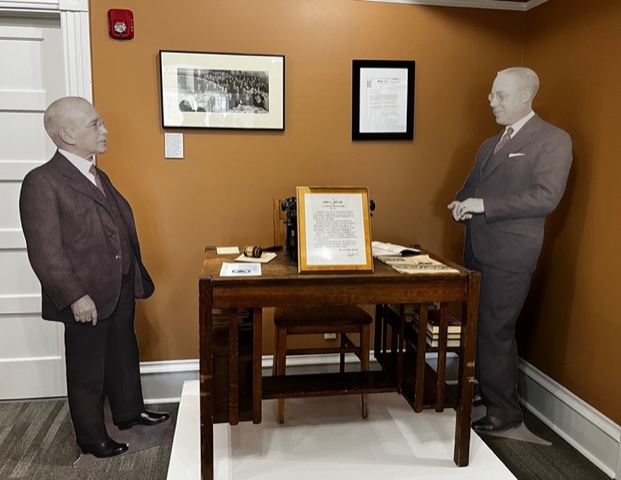Fighting for the future of credit unions, even though we might not be around to see it

On November 24, 1908, the “La Caisse Populaire, Ste-Marie” (The People’s Bank) became the first credit union in the nation. Monsignor Pierre Hevey, Pastor of Sainte-Mary’s parish in Manchester, New Hampshire had a goal to help the primarily Franco-American mill workers save and borrow money. It all began in the living room of a house at 420 Notre Dame Ave., which today is the site of America’s Credit Union Museum,(ACUM).

In 1934, the Federal Credit Union Act was signed into law by President Franklin D. Roosevelt to make credit available and promote thrift through a national system of nonprofit cooperative credit unions.
From 1934 to 1964 credit unions grew from 39 to 11,200. State chartered credit unions as of July, 1964, numbered approximately 10,600.
From a Federal Reserve Bank of San Francisco Economic Letter dated, August 4, 2006:
”While the total number of credit unions has fallen from a peak of 23,866 in 1969 to 9,483 in 2004, the rate of consolidation has slowed recently. Indeed, if the 1995-2004 rate of consolidation continued, for example, the US would still have over 5,000 credit unions in 2025.”
As of June of 2023 CUNA reported that there were 4,811 Federally insured credit unions left in the US. This does not include the 125 privately insured credit unions (or roughly 2 percent of the total). The median asset size is $55.4 million. There are still just a little under 3,000 credit unions with assets less than $100 million. They represent 62 percent of all credit unions. If the ongoing consolidation trend persists, there is a growing concern that numerous communities may find themselves devoid of banking services, essentially turning into “bank deserts.” These smaller, single-sponsor credit unions play a significant role in underscoring the unique value of credit unions. Their presence is crucial for fighting the constant threat of taxation.
Chartering new credit unions, whose job is it?
The state league system began in the 1930’s. One of the chief duties was to promote and help facilitate the chartering of new credit unions. Leagues also operated for profit “service corporations” that provided services like credit card processing, ATM networks, shared service centers, etc. for credit unions so they could compete. Currently, most leagues lack a clear understanding of the procedures involved in chartering new credit unions.
Today, it is very hard to start a new credit union. In the last six years, NCUA has granted 14 new charters. So far this year NCUA has granted two new charters, they are:
Members Only FCU, the first black-owned, woman-led, sorority-based digital banking financial institution in the US, headquartered in Chicago.
Generations United FCU in NYC. It will establish an intersection of faith and financial stability for members of the United Church of Christ.
To be clear, it is not the NCUA’s job to charter a new credit union, it’s their job to protect the insurance fund. They grant charters based on successful completion of the charter process. It appears that it is no one’s job to charter new credit unions (that I know of).
There is no shortage of groups of people that learn about the financial cooperative and want to start their own credit union. At the June 2023 board meeting, NCUA reported there were 55 applications currently in phase one of the chartering process. However, there is very little help to completing the application, no sample policies, procedures, bylaws, etc. Then there’s the issue of capital, which must be donated. And finally, the challenge of opening the doors.
Why are we losing small credit unions to merger?
As of June, 2023 we have lost 69 credit unions to merger. The number one reason for merger is “expanded services.” That’s what they fill out on the merger document. We can fix that with the CUSO model. Several already exist. Member Support Services in New Jersey and Plexcity (founded by state leagues). These organizations came together to pool their resources to share the cost of essential back-office services. This cooperative model is precisely what small credit unions need, offering a sustainable solution. Furthermore, it serves as a “plug and play” option for launching new credit unions, emphasizing the importance of collaboration rather than embarking on the journey alone.
I met with 20 small credit union CEOs last month at an event called CU Unite that was arranged by Connection Credit Union CEO, Scott Prior. We heard from every credit union in the room why they think it’s so difficult to run a small credit union today. One reason they cited, really caught me by surprise. It was the passing of HR 1151.
A butterfly flaps its wings … the cause and effect theory.
For those that don’t remember, HR 1151, was the result of a lawsuit against AT&T Family FCU and First National Bank. It went all the way to the Supreme Court. The credit union added three companies to their field of membership and the banks held that the law said the membership must be made up of people with something in common. The Supreme Court ruled against the credit union. This could have resulted in 16 million Americans having to divest themselves of their credit union memberships. We had to fight it. And so we did, with HR 1151, and we won. According to the CEOs of these small credit unions that threw the door wide open to expand fields of membership to communities. Lives, works, and worships in multiple counties became commonplace. Growth for growth sake became vogue. Then growth through merger became a strategy.
Today only 15 percent of all credit unions are over $1B in assets, while 77 percent are under $250M in assets. However, that 15 percent accounts for 75% of the total assets. This “wealth gap” mirrors the American economy at some level.
The “salary gap” in credit unions has also widened dramatically. According to a 2022 CUES Executive Compensation Survey, the total median executive compensation soared by up to 14.9% with the median total compensation (includes base salary and bonuses) being $451,227.00. Small credit unions cannot compete for talent as salaries continue to rise and very few in management at large credit unions would be willing to take a cut in pay to run a small credit union.
What can you do to help?
A small group of volunteers launched the CU De Novo Collective (CUDNC) two years ago at the Underground in Las Vegas. Since then, we have worked closely with the NCUA to streamline the new charter process and in our individual networks are identifying struggling small credit unions and getting them the resources they need to survive and avoid a merger. We are also in the development phase of a new CUSO that will provide leading-edge back-office and technology services to small and startup credit unions at a sustainable price.
There’s a lot of work to be done to save the movement, so if you would like to join us and continue to explore ways we can collaborate to gain economies of scale for small credit unions without merging, join the CUDNC.
We are fighting for the future of credit unions, even though we may not be around to see it!

